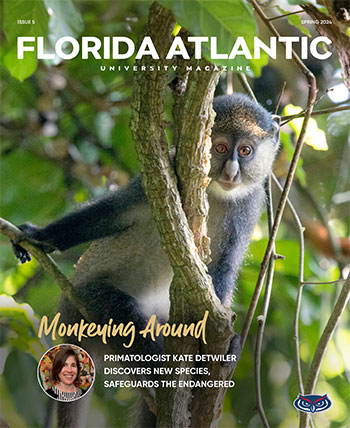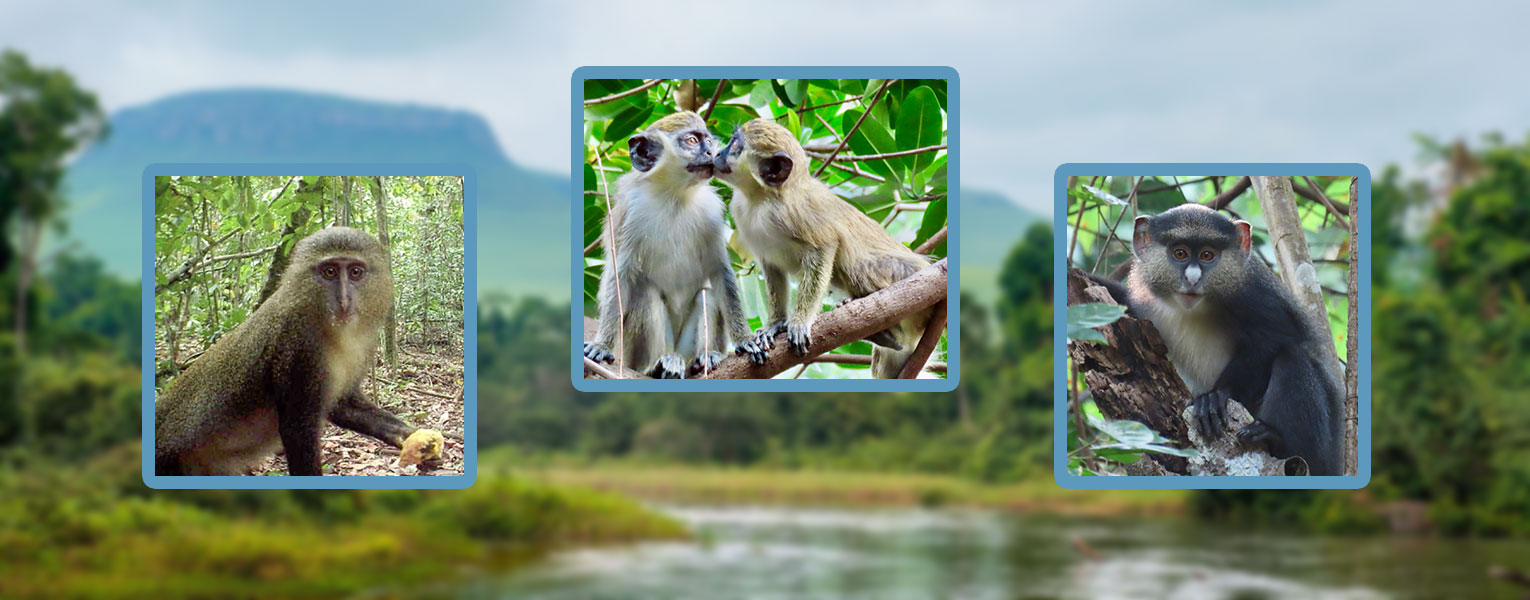5/23/2024
Florida Atlantic: Monkeys are her Business
A Peek into the Illustrious Career of Primatologist Kate Detwiler
By Gisele Galoustian
Often likened to the beloved Jane Goodall, Ph.D., Florida Atlantic University primatologist Kate Detwiler, Ph.D., shares a similar path. As conservation trailblazers who meticulously study their subjects in the wild without disturbing them, both also worked in the forests of Gombe National Park in Tanzania, living among chimpanzees and monkeys, and conducting groundbreaking research.
On an invitation from Detwiler, Goodall spoke at Florida Atlantic in 2019 to a sold-out crowd of 2,500. She emphasized the importance of protecting species and the environment, while encouraging others to do their part. Like Goodall, Detwiler, an associate professor of biological sciences in the Charles E. Schmidt College of Science, has an inquisitive spirit. Both credit their parents with encouraging their curiosity.
“As a child, I loved spending time outdoors looking for animals. One of my favorite memories is when I discovered the mating call of frogs after spending hours listening to their calls and watching the whole sequence between females and males unfold,” Detwiler said. “Now, as a primatologist, I still get to do what I loved to do as a kid, but with different species of monkeys in forests far away.”
As an early college student, Detwiler had plans to become a medical doctor. However, her aspirations took a turn during her junior year, when she spent a semester studying abroad in Tanzania at the College of African Wildlife Management. Her independent study project introduced her to an intriguing population of hybrid guenon monkeys in Gombe National Park, a tiny Tarzan-like dense jungle in the westernmost region of Tanzania.
She was instantly hooked, fascinated by the hybrid problem and the evolutionary processes of ecosystems. It was then that she knew her calling was to help protect wild nature so that healthy ecosystems can thrive.
“My early independent study and work on the hybrid monkeys in Gombe introduced me to a problem in nature that needed to be solved,” said Detwiler. “It’s been fascinating to see a shift in biology from thinking that hybridization is not common in animals to now having a better understanding of how hybridization is an important process in animal evolution. Gombe is an exceptional example of a rare natural laboratory and evolution in action, as it has a lot of successful hybrid monkeys to study.”
In addition to much-needed conservation efforts during her illustrious career, Detwiler and her team also have worked to solve the evolutionary puzzle of different species of monkeys using genomic research. In 2012, Detwiler’s research led to the discovery of a new species of monkey, Cercopithecus lomamiensis – locally known as the lesula – in the forests of the middle Lomami Basin in central Democratic Republic of the Congo. At the time, this was only the second new species of African monkey discovered in the last 28 years, which played a large role in the conservation of this endangered species.
This massive rainforest in the middle basin of the Lomami River was established as Lomami National Park in 2016. With its high biodiversity and ecological complexity, the park is home to numerous endemic and rare species, including lesula monkeys and dryas monkeys. Lomami National Park spans nearly 2.2 million acres, about 50 times larger than Washington, D.C., and is almost the size of Yellowstone National Park.
Detwiler also was the first to document that two genetically distinct species of guenon monkeys in Gombe National Park produced hybrid offspring. Using mitochondrial DNA from fecal samples, she examined the extent and pattern of genetic transfer or gene flow from “red-tailed” monkeys (Cercopithecus ascanius) to “blue” monkeys (Cercopithecus mitis) due to hybridization.
What she discovered was a lot of promiscuity. Red-tails were mating with blues, blues were mating with red-tails, blues were mating with blues, red-tails were mating with red-tails, and hybrids were mating with everyone. Yet, Detwiler didn’t find any negative consequences from these two very different species repeatedly mating and producing offspring on an ongoing basis.
“The Gombe hybrid population is extremely valuable because it can be used as a model system to better understand what hybridization looks like and how genetic material moves between species,” Detwiler said. “We have this amazing laboratory in nature to help us answer many questions about hybridization and how species boundaries are maintained. Our ongoing research is very timely because hybridization often occurs in response to environmental changes, as we are seeing with climate change and modified landscapes — it is nature’s way to respond.”
Whether Detwiler is extracting mitochondrial DNA from monkey feces in the lab or immersed deep in Central Africa’s rainforests with her students and collaborators, much of her research involves camera traps embedded in various habitats. These camera traps are equipped with infrared sensors to automatically and noninvasively capture videos without any disturbance to the monkeys and their social groups.
Although camera traps are widely used to detect and survey cryptic species, Detwiler, in collaboration with her students and colleagues, had to develop specific camera trap methods and placements for reliable and effective detection in one of the most remote regions in the world.
In 2017, using these specially designed remote sensing cameras, the research team was the first to capture rare video footage of the dryas monkey, a critically endangered species about the size of a cat. However, attempting to capture these dryas monkeys on camera was no easy feat and required unusual tactics. Detwiler solicited the help of her then-graduate student, Daniel Alempijevic, Ph.D., who received professional training to climb tall trees to strategically set up the cameras.
The picture-perfect details they obtained from these camera traps confirmed the occurrence of the elusive dryas monkey species at seven locations in both Lomami National Park and its buffer zone — spanning a total area of 3,453 square kilometers, based on opportunistic reports provided by local village residents and park patrols. Video footage also provided vital information on an array of other charismatic animals such as the bonobo, pangolin, African palm civet, and potto, which also inhabit the Lomami National Park.
“The Congo Basin rainforest is the second-largest rainforest in the world and contains some of the least-known species on the planet, many of which are threatened from hunting pressure and deforestation,” Detwiler said. “Our goal was to document where new dryas populations live and to develop effective methods to monitor population size over time to ensure their protection. Knowing where they live is important, because the animals living inside the Lomami National Park are protected, as it is illegal to hunt.”
Most recently, Detwiler published research findings on camera traps that documented — for the first time — the lesula’s terrestrial movement, daytime activity pattern, birth seasonality, group size and social organization. For the study, a research team established two systematic camera trap grids inside Lomami National Park and one outside the park in the buffer zone, where the animals are heavily hunted. They conducted three systematic, terrestrial camera trap surveys and accumulated 598 independent events of lesula over 5,960 camera trap days from 92 camera traps over a three-year period.
They discovered that the lesulas’ locomotor behavior is highly terrestrial, they have a daytime activity pattern, and they live in medium to large groups with one adult male, multiple adult females and their juveniles. The average group size from three surveys combined was 7.7 individuals.
Researchers recorded a total of 2,298 individuals: 1,163 were mature adult males and females, 696 were juveniles/infants/immature males and females. Lesula groups were comprised of multiple females with their infants and juveniles. Researchers also recorded single males and male-only groups comprising up to three males, which they identified as “bachelor” groups. Lesula groups mostly contain single males; however, some larger groups contained two mature males. Overall, 45 percent of all males identified were either lone males or in male-only groups.
“Our studies in the field truly illustrate how camera traps are a highly effective wildlife survey and research tool that provide a ‘behind the scenes’ method to obtain accurate information on the distribution of many different species, their activity patterns, habitat use and their abundance,” Detwiler said. “Because camera traps can run independently when field researchers aren’t around, they also contribute to conservation efforts by providing new approaches to collect life history and behavioral data, which can be applied to wildlife management.”
Throughout her career, Detwiler’s innate curiosity about animal behavior and passion for primatology have led to achievements far beyond her field. In addition to advancing knowledge of her primate subjects, her emphasis on ecological conservation has helped to protect their lives and habitats. And despite a growing body of information available about the natural world, Detwiler’s work proves there are still mysteries to be solved and species to be discovered.
If you would like more information, please contact us at dorcommunications@fau.edu.

Monkeys in South Florida
Sometimes, monkey business even follows Detwiler home. Her first doctoral student’s research project on a population of notorious monkeys in South Florida ultimately led to the confirmation of their origin. In 2021, using robust data and genetic research, Detwiler and Deborah “Missy” Williams, Ph.D., published their study findings. This research provided important evidence on the colony of non-native wild African vervet monkeys that landed in Dania Beach more than 70 years ago and settled in a thick mangrove forest near the Fort Lauderdale-Hollywood International Airport. Results of the study were widely shared by media nationally and internationally, delighting audiences near and far.
“Despite being non-native to the state of Florida, this group of African vervet monkeys has thrived for more than 80 years living in a swampy patch of forest adjacent to the airport,” said Williams, who founded the Dania Beach Vervet Project, a nonprofit organization dedicated to promoting awareness and conservation of the colony. “They originally escaped from a breeding facility in the 1940s called the Dania Chimpanzee Farm, which was both a research facility and a zoo. Since then, they have adapted incredibly well to life in the Sunshine State. Because they’ve been fed by people who offer snacks like fruits, nuts and seeds, they’re comfortable around humans and urban life.”
